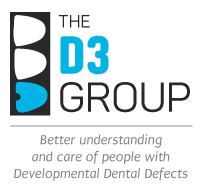GRACE SUCKLING – FROM DOYEN OF DDE TO PATRON OF D3G
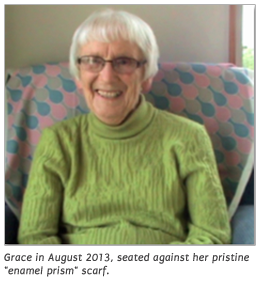
More than anyone, Grace Suckling defined our field.
With an unerring eye towards prevention, she firstly saw the need for dedicated research, then started sensibly with housekeeping (terminology & classification) before moving to aetiology (epidemiology & animal studies). Throughout, she did the basic groundwork, got initial results, refined her thinking and retested, then moved to the next question no matter what it entailed. This was pioneering in every sense of the word. Often it was complex work, yet the questions she posed for each D3 were simple: WHY this appearance, WHEN did it happen, WHAT caused it? All these remarkable accomplishments came from a dentist with no formal scientific training, and a mother who had raised 5 children – inspirationally, Grace started her research at the age of 50.
Grace's is a story of great science and wisdom that begged for translation. We hope this belated tribute will help admirers of her work to share it, and guide new students of D3 to understand key elements of our history that remain pivotal today. On the shoulders of a clever Kiwi we all stand – thanks for everything Grace, rest in peace.
Grace Webster Suckling (22/1/22 – 20/7/15)
- 1922, born in Dundee, Scotland
- 1939, started at Dundee Dental School
- 1939-56, dental training & practice, UK & USA
- 1956, moved to Wellington, NZ
- 1956-68, raised her family
- 1968, started at Dental Research Unit, Wellington
- 1969-89, research pioneer
- 1996, graduated Doctor in Dental Science (Otago)
- 2015, died in Waikanae, NZ
GRACE THE PATRON OF D3G

In 2013, Grace kindly agreed to be the inaugural Patron of D3G. Unable to join us for the website launch where her patronship was announced, then 91-year-old Grace emailed her best wishes (right) explaining she was away travelling overseas. Earlier, asking what could she possibly do as Patron, Grace was quick to admire today's desire for research translation and the progress made by D3G. After modest hesitation, she agreed to share some recollections with a view to us understanding her past and her inspiring our future. The outcome was a delightful interview, the preparation for which provided foundation for a later talk to paediatric colleagues.

Video interview by D3G-NZ rep, Erin Mahoney
- Long version (36 minutes)
- Short version shown at website launch (4 minutes)

Grace's talk to the NZ branch of ANZSPD, November 2013
- download [pdf]
Amongst many informative comments, one standout is Grace's lasting question about hypomineralised 6s – "why sometimes 1, 2, 3, or 4 teeth malformed?". She reported this aetiologically pivotal observation in 1976, yet little attention has been paid to it since and only recently have we begun to suspect a surprising answer.
LASTING GEMS FROM GRACE
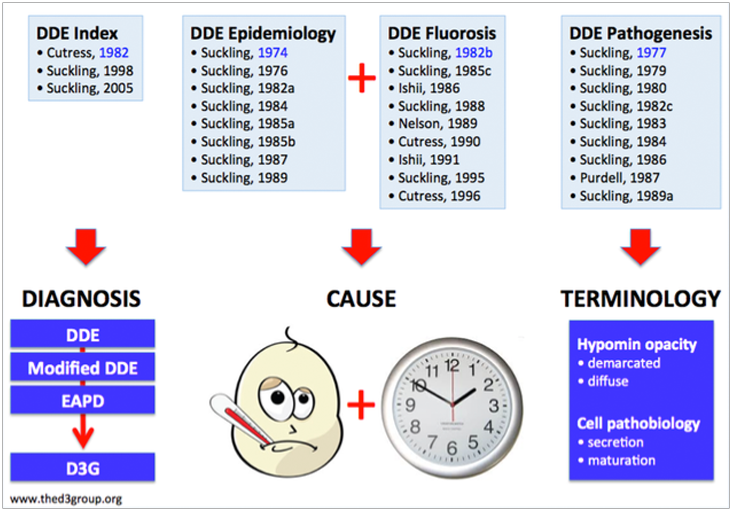
This translational depiction of Grace's research impacts was shown at the D3G website launch function in 2013. Later seeing this slide, Grace wrote "I have never seen my research career put into such clear categories. It does look impressive and so I maybe deserve to be your patron. I had to go and have a cup of coffee and think about it. I would like to help in anyway I can and agree with your outlook."
As summarised in the above figure, Grace's research has provided lasting impacts in three key areas:
(1) The DDE Index for Developmental Defects of Enamel
This groundbreaking diagnostic tool was spawned from Grace's frustration with the status quo, her astute observation skills, and a tenacity in conducting clinical trials. The DDE index remains the workhorse for dental epidemiology today, alongside later variants. Often overlooked, the now pivotal reporting of "atypical restorations and missing teeth" (i.e. linked to enamel defects, as distinct from typical caries in normal enamel) was introduced by Grace in 1984 and used by colleagues in 1985. Today, D3G's draft diagnostic guidelines extend her work with some fine-tuning to benefit translational applications.
(2) Aetiology
Before Grace there was loose understanding that various insults (trauma, fluoride, illness) acting at different times underlie many enamel defects, but the field was a dog's breakfast. After Grace, we had a robust sheep model showing precise correlations between trigger event (trauma, fluoride, infection), timing, and pathology (hypoplasia, demarcated and diffuse opacity). For us humans, timing was exquisitely refined through her analysis of a "fluoride accident" in Japan. She also showed that, despite being able to trigger demarcated opacities with infantile infection in sheep, any such causal link in human was invisible at population level – an enigmatic and disturbing predicament that persists today.
(3) Clinicopathological terminology
Before Grace there was little incentive to distinguish the clinical presentations of enamel defects, so few people did. After Grace, we had moved from three clinical descriptors (hypoplasia, demarcated opacity, diffuse opacity) to scientific terms that were mechanistically tied with pathology. Thus, hypoplasia was linked to deficiency in enamel secretion, and hypomineralised opacities to defective enamel maturation – with all three types having distinct aetiological origins. And loss of enamel from severe opacities (today's "post-eruptive breakdown") was rightfully distinguished from hypoplasia. Alas, despite this major advance made decades ago, little heed has been taken by most practitioners of today – an educational problem D3G is working hard to rectify!
GRACE THE DOYEN OF DDE
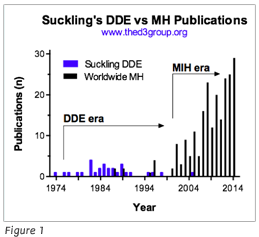
Grace's research kicked off what we hereby term the "DDE era". As Figure 1 shows, her DDE publications spanned more than 25 years, infiltrating what we in turn call the "MIH era". As evident in the bibliography below, this research spanned a broad array of disciplines and approaches, breaking vast tracts of new ground. In 1976, Grace was also first to publish the term "developmental defects of enamel" (DDE), in a paper title and according to PubMed at least. We think all of this qualifies her as doyen of the DDE era, and superstar in D3G eyes today.
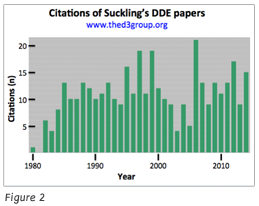
However, it is said that "pioneers get the arrows and settlers get the land", and such adage might indeed apply to Grace. Citations of her work have been quite steady over the years (Figure 2), earning today an h-index of 13 from >380 cites – highly respectable, all things considered. Yet surprisingly, her citation rate has not increased in parallel with the recent "explosion" in Molar Hypomin publications (Figure 1). To us this suggests an awareness problem that hopefully the scientific community and this webpage will help rectify. Earnest students of D3 simply must understand Grace's work.
GRACE'S BIBLIOGRAPHY
DDE epidemiology
- Suckling GW, Herbison GP, Brown RH. Etiological factors influencing the prevalence of developmental defects of dental enamel in nine-year-old New Zealand children participating in a health and development study. J Dent Res. 1987; 66(9):1466-9. PMID: 3476618
- Cutress TW, Suckling GW, Pearce EI, Ball ME. Defects of tooth enamel in children in fluoridated and non-fluoridated water areas of the Auckland region. N Z Dent J. 1985; 81(363):12-9. PMID: 3858707
- Suckling GW, Brown RH, Herbison GP. The prevalence of developmental defects of enamel in 696 nine-year-old New Zealand children participating in a health and development study. Community Dent Health. 1985; 2(4):303-13. PMID: 3866632
- Suckling GW, Pearce EI. Developmental defects of enamel in a group of New Zealand children: their prevalence and some associated etiological factors. Community Dent Oral Epidemiol. 1984;12(3):177-84. PMID: 6589109
- Suckling GW, Pearce EI, Cutress TW. Developmental defects of enamel in New Zealand children. N Z Dent J. 1976; 72(330):201-10. PMID: 1070583
- Suckling GW. Letter: Tetracycline-induced discolouration of teeth. N Z Med J. 1974; 80(528):464-5. PMID: 4532197
DDE Pathogenesis
- Suckling GW. Developmental defects of enamel--historical and present-day perspectives of their pathogenesis. Adv Dent Res. 1989; 3(2):87-94. PMID: 2701161
- Purdell-Lewis DJ, Suckling GW, Triller M, Jongebloed WL. Artificially induced developmental defects in sheep enamel examined by scanning electron microscopy. J Biol Buccale. 1987; 15(2):119-24. PMID: 3479426
- Suckling G, Elliott DC, Thurley DC. The macroscopic appearance and associated histological changes in the enamel organ of hypoplastic lesions of sheep incisor teeth resulting from induced parasitism. Arch Oral Biol. 1986; 31(7):427-39. PMID: 3467666
- Suckling G, Thurley DC. Histological, macroscopic and microhardness observations of fluoride-induced changes in the enamel organ and enamel of sheep incisor teeth. Arch Oral Biol. 1984; 29(3):165-77. PMID: 6587836
- Suckling G, Elliott DC, Thurley DC. The production of developmental defects of enamel in the incisor teeth of penned sheep resulting from induced parasitism. Arch Oral Biol. 1983; 28(5):393-9. PMID: 6578757
- Suckling GW, Purdell-Lewis DJ. The pattern of mineralization of traumatically-induced developmental defects of sheep enamel assessed by microhardness and microradiography. J Dent Res. 1982; 61(10):1211-6. PMID: 6956605
- Suckling G. Defects of enamel in sheep resulting from trauma during tooth development. J Dent Res. 1980; 59(9):1541-8. PMID: 6931141
- Suckling G. Mineralization of the enamel of ovine permanent central incisor teeth using microhardness and histological techniques. Calcif Tissue Int. 1979; 28(2):121-9. PMID: 116728
- Suckling GW, Cutress TW. Traumatically induced defects of enamel in permanent teeth in sheep. J Dent Res. 1977; 56(11):1429. PMID: 274475
DDE biophysics
- Suckling GW, Nelson DG, Patel MJ. Macroscopic and scanning electron microscopic appearance and hardness values of developmental defects in human permanent tooth enamel. Adv Dent Res. 1989; 3(2):219-33. PMID: 2640433
- Suckling GW, Purdell-Lewis D. Macroscopic appearance, microhardness and microradiographic characteristics of experimentally produced fluorotic lesions in sheep enamel. Caries Res. 1982; 16(3):227-34. PMID: 6954000
DDE Index
- Suckling G.
DDE index. N Z Dent J. 2005; 101(4):110; PMID: 16416749
- Suckling GW. History of the DDE indices. N Z Dent J. 1998; 94(415):9-11. PMID: 9584449
- Cutress TW, Suckling GW. The assessment of non-carious defects of enamel. Int Dent J. 1982; 32(2):117-22. PMID: 6956547
DDE Fluorosis
- Cutress TW, Suckling GW, Coote GE, Gao J. Fluoride uptake into the developing enamel and dentine of sheep incisors following daily ingestion of fluoridated milk or water. N Z Dent J. 1996; 92(409):68-72. PMID: 8910725
- Suckling G, Coote GE, Cutress TW, Gao J. Proton microprobe assessment of the distribution of fluoride in the enamel and dentine of developing central incisors of sheep and changes induced by daily fluoride supplements. Arch Oral Biol. 1995; 40(5):439-46. PMID: 7639647
- Ishii T, Suckling G. The severity of dental fluorosis in children exposed to water with a high fluoride content for various periods of time. J Dent Res. 1991; 70(6):952-6. PMID: 2045574
- Cutress TW, Suckling GW. Differential diagnosis of dental fluorosis. J Dent Res. 1990; 69 Spec No:714-20; discussion 721. PMID: 2179334
- Nelson DG, Coote GE, Vickridge IC, Suckling G. Proton microprobe determination of fluorine profiles in the enamel and dentine of erupting incisors from sheep given low and high daily doses of fluoride. Arch Oral Biol. 1989; 34(6):419-29. PMID: 2597035
- Suckling G, Thurley DC, Nelson DG. The macroscopic and scanning electron-microscopic appearance and microhardness of the enamel, and the related histological changes in the enamel organ of erupting sheep incisors resulting from a prolonged low daily dose of fluoride. Arch Oral Biol. 1988; 33(5):361-73. PMID: 3190523
- Ishii T, Suckling G. The appearance of tooth enamel in children ingesting water with a high fluoride content for a limited period during early tooth development. J Dent Res. 1986; 65(7):974-7. PMID: 3458759
- Suckling G. Fluoridation of water. N Z Med J. 1985; 98(790):968. PMID: 3866181
- Suckling GW. False diagnosis of fluorosis. Br Dent J. 1982; 153(6):212. PMID: 6958283
DDE Doctoral thesis
- Suckling, GW. Developmental defects of dental enamel. Doctor of Dental Science Thesis. University of Otago, 1996.
Other publications
- Orr MB, Suckling G. Broken incisors - a cause of hogget illthrift. N Z Vet J. 1985; 33(7):104. PMID: 16031178
- Pearce EI, Suckling GW, Cutress TW. Fluoride in the outer enamel of New Zealand children. II. Its relation to caries experience. N Z Dent J. 1982; 78(351):8-11. PMID: 6950259
- Pearce EI, Suckling GW, Cutress TW. Fluoride in the outer enamel of New Zealand children. I. Its relation to the fluoride concentration of the water supply and to the use of fluoride tablets. N Z Dent J. 1981; 77(350):144-9. PMID: 6947156
- Craig EW, Suckling GW, Pearce EI. The effect of a preventive programme on dental plaque and caries in school children. N Z Dent J. 1981; 77(349):89-93. PMID: 6944630
- Pearce EI, Craig EW, Suckling GW. Stability of fluoride levels in surface layer of normal enamel during a 21-month fluoride mouthrinsing program. Community Dent Oral Epidemiol. 1980; 8(8):396-400. PMID: 7021057
- Suckling G. Remineralisation. N Z Sch Dent Serv Gaz. 1979; 40(2):12-3. PMID: 293629
- Roil MR, Suckling GW, Mattingley J. Serum total protein and albumin levels in grazing sheep. N Z Vet J. 1974; 22(12):232-6. PMID: 4534013
- Pearce EI, Suckling GW. Fluoride compounds and reagents for topical use in caries preventive programmes. N Z Dent J. 1974; 70(322):255-60. PMID: 4533059
- Cutress TW, Suckling GW, Healy WB, Mattingley J, Aitken WM. Periodontal disease in sheep. II. The composition of sera from sheep with periodontosis. J Periodontol. 1972; 43(11):668-76. PMID: 4508346
- Cutress TW, Suckling GW, Brown RH. Periodontal disease and serum citric acid levels in trisomy-21. A further study. Arch Oral Biol. 1971; 16(11):1367-70. PMID: 4258513
- Cutress TW, Suckling GW, Brown RH. Periodontal disease and serum citric acid levels in trisomy-21 (mongolism). Arch Oral Biol. 1969; 14(9):1129-31. PMID: 4242249
